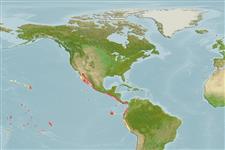Environment: milieu / climate zone / depth range / distribution range
Ecologia
marino demersale; distribuzione batimetrica 0 - 300 m (Ref. 9269), usually 0 - 95 m (Ref. 9269). Subtropical; 34°N - 15°S
Eastern Pacific: Santa Catalina Island, southern California, USA to Peru.
Size / Peso / Age
Maturity: Lm ? range ? - ? cm
Max length : 33.0 cm TL maschio/sesso non determinato; (Ref. 55763); common length : 15.0 cm TL maschio/sesso non determinato; (Ref. 55763)
Short description
Chiavi di identificazione | Morfologia | Morfometria
Spine dorsali (totale) : 3; Raggi dorsali molli (totale) : 12 - 14; Spine anali: 0; Raggi anali molli: 8 - 9; Vertebre: 19. Branchiostegal rays: 6 (Ref. 36491).
Adults inhabit rocky areas, including the intertidal zone. Found on sandy and muddy bottoms (Ref. 9269). Young individuals feed heavily on crustaceans but as they grow bigger, they consume more and more fish, sometimes catching and eating fishes their own size (Ref. 4930).
Eschmeyer, W.N., E.S. Herald and H. Hammann, 1983. A field guide to Pacific coast fishes of North America. Boston (MA, USA): Houghton Mifflin Company. xii+336 p. (Ref. 2850)
IUCN Red List Status (Ref. 130435: Version 2024-1)
Threat to humans
Harmless
Human uses
Strumenti
Special reports
Download XML
Fonti Internet
Estimates based on models
Preferred temperature (Ref.
123201): 15.7 - 28.8, mean 23.3 °C (based on 270 cells).
Phylogenetic diversity index (Ref.
82804): PD
50 = 0.5312 [Uniqueness, from 0.5 = low to 2.0 = high].
Bayesian length-weight: a=0.02630 (0.01029 - 0.06725), b=2.96 (2.73 - 3.19), in cm total length, based on LWR estimates for this (Sub)family-body shape (Ref.
93245).
Trophic level (Ref.
69278): 4.0 ±0.66 se; based on food items.
Resilienza (Ref.
120179): Alto, tempo minimo di raddoppiamento della popolazione meno di 15 mesi (Fec assumed to be > 10,000).
Fishing Vulnerability (Ref.
59153): Low vulnerability (23 of 100).
